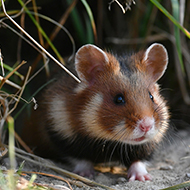European hamsters and lemurs added to IUCN Red List

"More research into the various possible drivers of the European hamster’s disappearance is urgently needed."
Lemurs, European hamsters and North Atlantic right whales are among the species now listed as Critically Endangered on the IUCN's Red List of Threatened Species.
The additions bring the total number of species on the list to 120,372 species, of which 32,441 are threatened with extinction.
According to the IUCN, 33 lemur species are listed as Critically Endangered, with 103 of the 107 surviving species threatened with extinction. Deforestation and hunting in Madagascar are believed to be attributed to this decline.
Thirteen lemur species have also been pushed to higher threat categories as a result of intensifying human pressures. These include the Verreaux’s Sifaka (Propithecus verreauxi) and Madame Berthe's Mouse Lemur (Microcebus berthae), the smallest primate in the world.
Dr Grethel Aguilar, IUCN acting director-general, commented: “This IUCN Red List update exposes the true scale of threats faced by primates across Africa. It also shows that Homo sapiens needs to drastically change its relationship to other primates, and nature as a whole.
“At the heart of this crisis is a dire need for alternative, sustainable livelihoods to replace the current reliance on deforestation and unsustainable use of wildlife. These findings really bring home the urgent need for an ambitious post-2020 biodiversity framework that drives effective conservation action.”
The European hamster 'is expected to go extinct within the next 30 years' if nothing changes, says the IUCN. While a female hamster had an average of over 20 offspring annually during most of the 20th century, females today have been found to give birth to only five to six pups a year.
The reasons for the reduced reproduction rates are not yet fully understood, says the IUCN. But climate change, light pollution and industrial development are thought to be likely causes.
“While conservation measures including hamster-friendly field management and reintroductions have slowed down the population decline in some areas, they have failed to reverse the trend,” said Dr Mikhail Rusin, an author of the new Red List assessment, member of the IUCN SSC Small Mammal Specialist Group and head of the hamster restoration project in Kiev Zoo, Ukraine.
“In addition to these measures, more research into the various possible drivers of the European hamster’s disappearance is urgently needed to save it from extinction.”
The North Atlantic right whale has been moved from Endangered to Critically Endangered on the IUCN Red List. There are now fewer than 250 mature individuals estimated to be alive.
The decline of this species is thought to be driven by a combination of increased mortality due to entanglement in fishing gear and vessel strikes, and a lower reproduction rate compared to previous years.
Dr Jane Smart, global director of the IUCN Biodiversity Conservation Group commented: “The dramatic declines of species such as the North Atlantic Right Whale included in today’s IUCN Red List update highlight the gravity of the extinction crisis. Saving the fast-growing number of threatened species from extinction requires transformational change, supported by action to implement national and international agreements.
“The world needs to act fast to halt species’ population declines and prevent human-driven extinctions, with an ambitious post-2020 biodiversity framework which the upcoming IUCN Congress will help define.”



 BSAVA is to partner with BVA Live (11-12 June 2026) to champion clinical research.
BSAVA is to partner with BVA Live (11-12 June 2026) to champion clinical research.